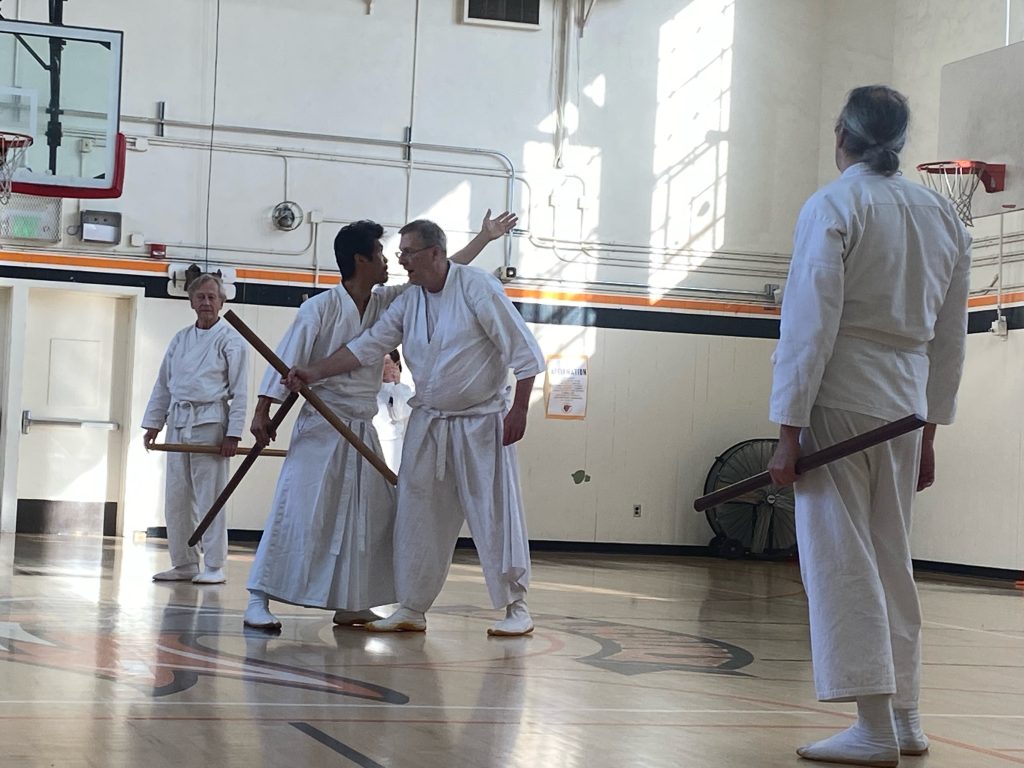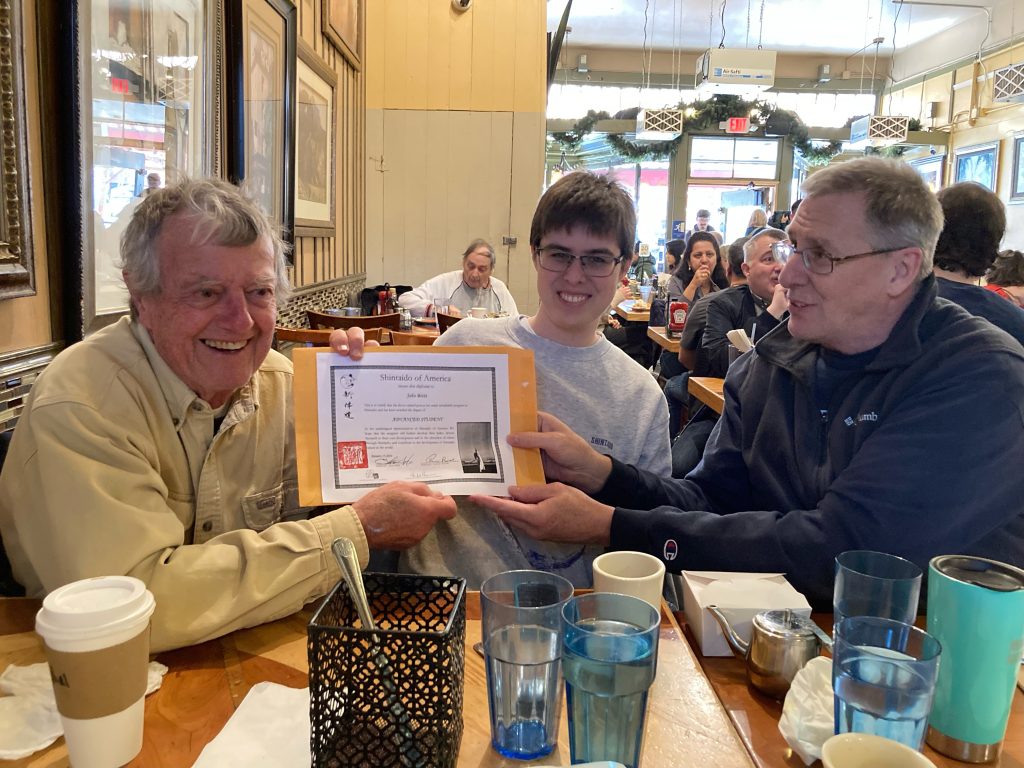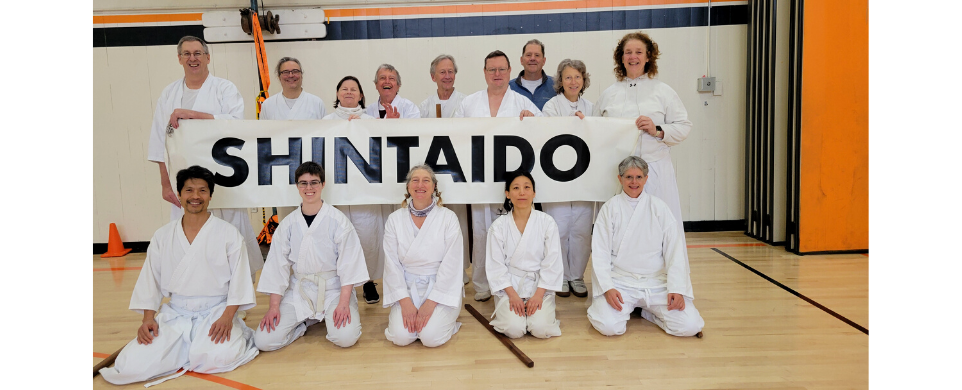by Derk Richardson
Over the 2024 Martin Luther King Jr. weekend, Pacific Shintaido hosted its annual Kangeiko workshop in the Claremont Middle School gymnasium in Oakland, California.
Master Ito Sensei died on December 30, 2023, just a few weeks before Kangeiko 2024, and his spirit infused the entire weekend.
General Instructor Connie Borden and Senior Instructors Robert Gaston and Shin Aoki were our instructors, guiding us through four keiko (two on Saturday, two on Sunday) and each, in their own way, developing and leading kenjutsu-based curriculum inspired by the theme “Finding Center.”
By inviting Connie Sensei, Rob Sensei, and Shin Sensei to instruct, the Pacific Shintaido board (Shin Aoki, Cheryl Williams, and Derk Richardson) was providing them the opportunity to share some of what they had gleaned from their recent international travels—Connie Sensei and Rob Sensei to British Shintaido Daienshu 2023 last August, and Shin Sensei to a gasshuku in Japan last October.
The PacShin board came up with the theme as a general, rather than prescriptive, concept, and in his opening remarks on Saturday morning, Derk mentioned a few ideas that came to mind when the Board conjured the theme: We live in increasingly polarized times when finding center is essential; Shintaido movement originates from the center and returns to the center; in kumite, we find out partner’s center, find our own center, and connect the two, becoming one; the center can be a slippery target, requiring our concentration, awareness, and sensitivity to find it; the sword (bokuto, bokken) can be a compass to help us find center; finding center is connecting with our true selves; finding center enables us to take refuge in stillness.

A dozen Shintaido practitioners, from the greater San Francisco Bay Area, and also from Oregon and Florida, participated during the weekend. Each keiko was taught entirely by one instructor. On Saturday morning, after Sandra Bengstsson led warmups, Shin Sensei led the class through tachi jumping, wakame kumite that involved sensing the layers leading to the partner’s center, and irimukae—stepping forward and backward holding the bokuto perpendicularly and “entering” the sword and letting the sword “enter” you. The keiko also included Tenshingoso with sword, both individually and facing a partner; stepping practice (steps number three, four, five, and six), adding chudan cutting with sword, and kumitachi—daijodan versus chudan kiriharai.
After a midday potluck brunch hosted by Shin Sensei and Robert Friedman at their home in the Oakland hills, keiko two began with Nao Kobayashi leading warmups. Rob Sensei introduced a form of renki kumite to foster connection, with one partner using an open palm to receive the other partner’s fist. After pushing back and forth, the receiver would draw and send the attacker away. The next stage was for the receiver to apply the other hand to the back of the attacker’s arm or shoulder while sending away. The keiko concluded with daijodan versus chudan kumite first with open-hand cuts and then with sword. The differing levels of Shintaido experience among the participants allowed for a wide variety of partner-pairing.
On Sunday morning, Sally Gaston led warmups (fulfilling one element of her Shintaido Assistant exam, which she would successfully complete the next day). Connie Sensei then led the group in tachi jumping with increasingly quicker partner changes, the frenzied pace had everybody laughing. She settled us down with standing meditation before instructing us in Diamond Eight cut sei, using bokken, both stationary in place and with a triangle stepping pattern. The final exercise Connie Sensei introduced involved the opening three steps of Okuden no Kata, receiving/avoiding a daijodan cut from behind.
After lunch at a local restaurant, Derk led warmups for the final keiko, which Shin Sensei taught as a kind of synthesis, summation, and extension of the preceding curricula. We again did renki kumite, this time stepping back and forth, remaining connected by the backs of our wrists, and searching for one another’s center. After individual open-hand toitsu kihon (daijodan, jodan kirikomi, and chudan kirikomi cuts), we proceeded to kirioroshi kumite with various partners. Following that, Shin Sensei led us in Kyukajo #2 (nikajo) and #3 (sankajo), two of the nine-plus techniques fundamental to classic Shintaido Kenjutsu practice. Kyukajo #2 is daijodan sword cut versus jodan, #3 is daijodan versus chudan.

Those of who had attended Pacific Shintaido Kangeiko 2020, “Rediscovering Kyukajo,” might have recalled that Master Instructor H.F. Ito had shared his understanding of three elements basic to formal Kyukajo practice: It should be done with bokuto; stepping sequences all end by drawing the feet into musubidachi stance; and each kumite begins with partners bowing to each other, drawing their swords into shoko position, lifting their swords in tandem into tenso, and returning together down to shoko. The partners repeat shoko-tenso and bow at the conclusion of kumitachi, as well.
The energy level of the keiko escalated dramatically with several rounds of Eiko Dai kumite with sword, partners running toward one another from opposite corners of the gym, one cutting with daijodan, the other cutting jodan or chudan. We concluded the keiko with Tenshingoso kumite, first in partner pairs and then all together.
Upon reflection, it is clear that every exercise and technique led by our instructors—Connie Sensei, Shin Sensei, and Rob Sensei—during Kangeiko 2024 advanced our understanding of and brought us physically closer to “finding center.” We extend our gratitude to them for deepening our understanding, polishing our techniques, strengthening our relationships within the Shintaido community, and inspiring us to take our practice out into the world in our everyday lives.
In the closing ceremony, Derk read a poem by the Chinese-American poet Ha Jin:
A Center
You must hold your quiet center,
where you do what only you can do.
If others call you a maniac or a fool,
just let them wag their tongues.
If some praise your perseverance,
don’t feel too happy about it—
only solitude is a lasting friend.
You must hold your distant center.
Don’t move even if earth and heaven quake.
If others think you are insignificant,
that’s because you haven’t held on long enough.
As long as you stay put year after year,
eventually you will find a world
beginning to revolve around you.




Thank you Derk. And thank you for the poem.